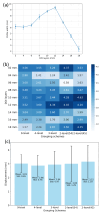Depth-of-interaction encoding techniques for pixelated PET detectors enabled by machine learning methods and fast waveform digitization
- PMID: 40185124
- PMCID: PMC11995716
- DOI: 10.1088/1361-6560/adc96d
Depth-of-interaction encoding techniques for pixelated PET detectors enabled by machine learning methods and fast waveform digitization
Abstract
Objective. Pixelated detectors with single-ended readout are routinely used by commercial positron emission tomography scanners owing to their good energy and timing resolution and optimized manufacturing, but they typically do not provide depth-of-interaction (DOI) information, which can help improve the performance of systems with higher resolution and smaller ring diameter. This work aims to develop a technique for multi-level DOI classification that does not require modifications to the detector designs.Approach. We leveraged high-speed (5 Gs s-1) waveform sampling electronics with the Domino Ring Sampler (DRS4) and machine learning (ML) methods to extract DOI information from the entire scintillation waveforms of pixelated crystals. We evaluated different grouping schemes for multi-level DOI classification by analyzing the DOI positioning profile and DOI positioning error. We examined trade-offs among crystal configurations, detector timing performance, and DOI classification accuracy. We also investigated the impact of different ML algorithms and input features-extracted from scintillation waveforms-on model accuracy.Main results. The DOI positioning profile and positioning error suggest that 2- or 3-level binning was effective for 20 mm long crystals. 2-level discrete DOI models achieved 95% class-wise accuracy and 83% overall accuracy in positioning events into the correct DOI level and 3-level up to 90% class-wise accuracy for long and narrow crystals (2 × 2 × 20 mm3). Long short-term memory networks trained with time-frequency moments were twice as efficient in training time while maintaining equal or better accuracy compared to those trained with waveforms. Classical ML algorithms exhibit comparable accuracy while consuming one order less training time than deep learning models.Significance. This work demonstrates a proof-of-concept approach for obtaining DOI information from commercially available pixelated detectors without altering the detector design thereby avoiding potential degradation in detector timing performance. It provides an alternative solution for multi-level DOI classification, potentially inspiring future scanner designs.
Keywords: depth-of-interaction (DOI); long short-term memory (LSTM); machine learning (ML); waveform sampling (WFS).
Creative Commons Attribution license.
Figures











References
-
- Alcolea A, Resano J. FPGA accelerator for gradient boosting decision trees. Electronics. 2021;10:314–28. doi: 10.3390/electronics10030314. - DOI
-
- Bruyndonckx P, Léonard S, Tavernier S, Lemaître C, Devroede O, Wu Y, Krieguer M. Neural network-based position estimators for PET detectors using monolithic LSO blocks. IEEE Trans. Nucl. Sci. 2004;51:2520–5. doi: 10.1109/TNS.2004.835782. - DOI
MeSH terms
Grants and funding
LinkOut - more resources
Full Text Sources
Miscellaneous
